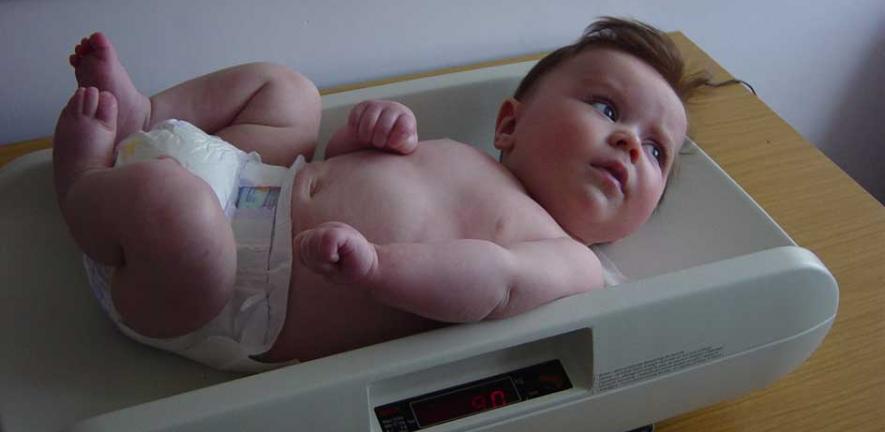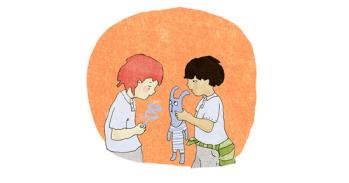
A study of infant growth, tracking 2,400 babies from gestation to the age of two, has provided data of unique depth – and is already adding to our understanding of the development of life-threatening conditions, including obesity. The Cambridge University scientists who led the research now plan to follow the same children through another key phase of development - puberty.
A study of infant growth, tracking 2,400 babies from gestation to the age of two, has provided data of unique depth – and is already adding to our understanding of the development of life-threatening conditions, including obesity. The Cambridge University scientists who led the research now plan to follow the same children through another key phase of development - puberty.
Working with our colleagues in fields such as psychology and psychiatry allows us to build up as full a picture as possible of human development.
Professor Ieuan Hughes
Ten years ago Cambridge University’s Department of Paediatrics launched a major research project to study the effects of the environment on the developing foetus and young infant. The Cambridge Baby Growth Study (CBGS) recruited 2,400 pregnant mothers to take part in the research. The study represents the most in-depth study of its kind world-wide in terms of the detail it captured.
The data gathered by CBGS is providing a whole community of scientists – right from physiologists to psychologists – with a rich resource for understanding more about child development and how it is affected by the environment. Researchers in Cambridge and elsewhere are using the CBGS data to produce important findings in areas such as the foetal origins of adult disease, notably diabetes, and the onset of conditions that include obesity.
In the course of the research, scientists collected biological samples from the mother and child. These included maternal blood during pregnancy, paternal DNA, cord blood, placentas, breast milk and infant serum as well as infant blood taken at intervals up to the age of two. New technologies were developed to measure hormones and chemicals in tiny spots of blood taken using the heel prick technique to minimise invasiveness.
Participants brought their babies into the research clinic at the age of 12 months and 24 months. Before these visits food diaries were sent out for completion. These diaries were coded at the MRC’s Human Nutrition Research Centre using its in-house database system. The database contains nutritional information on many thousands of different food and drinks. Macro-nutrients such as fat, protein and carbohydrates, and micro-nutrients such as vitamins and minerals were analysed. Mothers kept detailed diaries which covered meals, home-made recipes and preparation methods as well as how much their child ate; this information is enabling researchers to understand more about the complex nutritional factors which may be influencing how babies grow and develop.
CBGS began as part of a European Union research project involving centres in six European countries. Its initial remit was to focus on the study of environmental chemicals, known as endocrine disrupters, on male reproductive health, which has become a major concern in recent years. Participants were recruited at the first pre-natal hospital visit. At this point the sex of the foetus was unknown. Rather than drop around half of the recruits when it became clear which were boys and which girls, CBGS decided to retain all the children.
“To lose about 50 per cent of our recruits would have been a huge wasted opportunity. So we decided to retain the girls as well as the boys and use the data to build a resource that could tell us a tremendous amount about early years’ development and its implications for health – and about the role of nutrition in particular,” said Professor Ieuan Hughes, Head of Paediatrics at Cambridge.
CBGS has already enabled scientists to learn more about the complex and often inter-related factors that might contribute to the development of male reproductive health problems and a number of life-threatening diseases.
Data gathered from the male infants studied points to a doubling of the incidence of undescended testes since the 1960s, with around six per cent of boys at birth experiencing this problem today. The anogenital distance (distance between the anus and the genitalia) has been defined as a marker of androgen (steroid hormone) exposure. A clinical study is underway to analyse the anogenital distance in 100 infants having surgery. Cases of undescended testes are also being analysed in relation to CBGS drawn from biological samples and lifestyle information.
The study has also shown that infants formula-fed at three months have higher insulin-like growth factor levels and greater gains in weight, length, fat levels and body mass index than those who were breast-fed. Preliminary data suggests that energy intake at 12 months predicts gains in body weight and fat at 24 months. Further investigations are planned to take these findings further. A Baby Milk Feeding Programme – offering advice to mothers using formula – is being piloted.
As a spin-out from CBGS, paediatricians Dr Ken Ong (Cambridge MRC Epidemiology Unit) and Dr Carlo Acerini are recruiting infants at birth who are either born small or large. Many babies born large are infants of children whose mothers either have diabetes or have developed a diabetic tendency while pregnant. “Big babies who have been exposed to higher sugar levels than others in the womb seem to grow slowly initially but are more likely to be bigger children or adults. Babies born small often grow slowly but many tend to be shorter as children or adults,” said Dr Acerini.
“We will be looking at how environmental factors, hormones and inherited factors affect growth in these babies. If we can identify early markers, we can understand and predict later growth patterns. This will help us to find out which babies are at the higher risk.”
The CGBS data is also being used to promote understanding of topics such as gender identity and autism. “Working with our colleagues in fields such as psychology and psychiatry – both at Cambridge and beyond - is an important aspect of the study as it allows us to build up as full a picture as possible of human development,” said Professor Hughes.
One of the strengths of CBGS is the way in which both researchers and research nurses have worked with parents and children to foster a research community linked by a newsletter. At a party held earlier this year to mark the tenth anniversary of the study, parents had the chance to hear first-hand from experts in areas such as glucose levels and infant growth.
A substantial part of the data was gathered by a team of five research nurses whose role was vital. The expertise of these nurses is recognised by the Food Standards Agency which uses the information they gather to get accurate data on what we eat as a population and to inform government policy. For the last three years of the study funding for the nurses came from the Mothercare Group Foundation.
“We need to retain the valuable and irreplaceable resources represented by our research nurses. The generosity of the Mothercare Group Foundation has allowed us to reach this point and we are determined to realise the fruits of such investment by taking the original study forward to cover the teenage years,” said Professor Hughes.
The parents involved in CBGS saw their involvement in pioneering research as a chance to “give something back” to society and regarded the tracking of their children’s growth by professionals as an added benefit. Many parents said that taking part had been a fascinating experience and many have expressed a desire to continue with the study as their children grew up.
With so many parents willing for their children to be tracked through puberty, Professor Hughes is keen that the substantial foundation of data should be followed up with a second phase of the study.
“The children we recruited in the first year of the study are now reaching ten and those we recruited most recently are now two years old. With our oldest children now approaching puberty, we have a unique chance to bring them back into the study in order to gather data that will enable us to address key questions about puberty – such as the onset of adult diseases and conditions,” he said.
Along with a number of centres in Europe, Professor Hughes and colleagues are currently making an application for EU funding for a large study of what has been described as the “exposome” - embracing everything that a human could be exposed to that influences health and well-being. It would include chemicals, food and genes among other factors. CBGS represents a well-documented population.
A follow-up study would enable researchers to look at the relationship between data gathered from the infants studied in the first phase (prenatal to two years old) and data gathered before and during puberty. An understanding of obesity and its prevention is one area where the study could make a valuable contribution by exploring how growth and development in early life might be related to later problems.
“Our investment in CBGS means that we are in a position to discover how we can reduce the health risks contained in our ever changing environment. Notably we will be able to learn how best to prevent the childhood obesity epidemic which is no longer just a scare mongering exercise: it’s a reality,” said Professor Hughes.
Case studies
CASE STUDY 1 Lynne says: “My two daughters, who are now aged two and four, were part of the CBGS, the first child from 2007 to 2009 and the second from 2009 to 2011. I was approached to take part in the research while attending the antenatal clinic at 12 weeks’ pregnancy. I completed a detailed lifestyle questionnaire during my pregnancy and again three months after birth: this covered general health and also products used at home such as food and toiletries. I was given a detailed glucose tolerance test which gave more information than the standard prenatal test and provided some additional blood samples throughout the pregnancy. The girls' father also provided DNA samples. At birth, small samples of cord blood and placenta were taken; a sample of breast milk was also collected over the first three months. At intervals across two years, research nurses measured the girls’ growth, took abdominal ultrasounds to measure their fat and blood samples to analyse hormone levels. I kept food diaries recording details of each child’s diet at both one and two years of age. I’m keen to see the study continue so that my daughters, and others, can be followed through puberty. The girls will be able to make up their own minds whether they want to take part. I’ve kept all the newsletters so they will be able to read about the study so far. I hope they will agree to contribute to the continuation of this exciting research.”
CASE STUDY 2 Sarah says: “My son and daughter, who are now five and three, took part in the Baby Growth Study from 2006 to 2010. I was delighted to help with the research to further what we know about children’s growth and development and the factors which play a role in the health of a child. After a while we became well acquainted with the researchers and attending sessions was like catching up with old friends and it was interesting to hear about the latest developments in the project. It was great to attend the Baby Growth Study celebration party in May 2011, to meet other parents and children who were involved in the research and to hear about some of the results so far. During the study I was made more aware of potential factors which might affect children’s growth and development, such as exposure to cleaning products, hair dyes and paints. I avoided decorating my house during my pregnancies and while I was breast feeding, as a result of completing the environmental factors questionnaire! Keeping the food diaries made me think more carefully about my children’s diet. I am a GP and results of studies such as this will aid me, and fellow healthcare professionals, when advising patients in the future and will help us promote the healthiest lifestyle possible to ensure the next generation is as healthy as possible.
This work is licensed under a Creative Commons Licence. If you use this content on your site please link back to this page.





